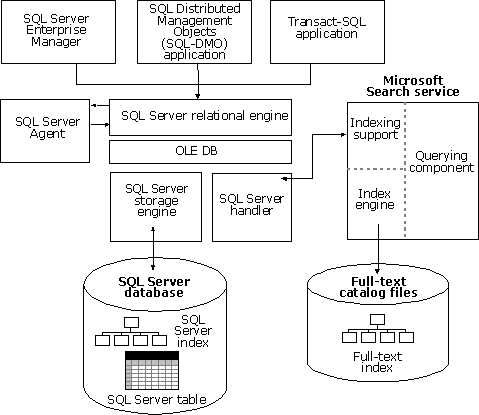
This illustration shows the components that make up the full-text indexing support. These are the components involved in defining, creating, and populating full-text indexes.

Enabling databases and tables for full-text indexing, defining and populating the indexes is specified using:
One of the nodes of a database tree in the SQL Server Enterprise Manager GUI is used to manage the full-text catalogs in the database.
SQL-DMO has objects for managing full-text catalogs and indexes.
Transact-SQL has a set of system stored procedures for managing full-text catalogs and indexes.
The other components are involved in defining and populating full-text indexes in this manner:
The population in Step 6 can take different forms.
Index entries are built for all the rows in all the tables covered by the full-text catalog. A full population typically occurs when a catalog is first populated.
Only adjusts index entries for rows that have been added, deleted, or modified after the last population. This ability requires that the indexed table have a column of the timestamp data type. If the table does not have a timestamp column, only full populations can be performed. Requests for incremental populations on tables without timestamp columns result in a full population operation.
If a new full-text index is defined for a table that has not been associated with the catalog before, the next incremental population request for the catalog builds all the entries for the table.
Incremental population requests are implemented as full populations if any of the metadata for the table has changed since the last population. This includes altering any column, index, or full-text index definitions.
Typically, a full-text catalog will be defined and initially have a full population executed. Incremental population operations are then run at intervals to pull across new data that has been added to the indexed columns in SQL Server. These periodic incremental population operations are usually defined as jobs and are dispatched automatically by the SQLServerAgent service.
| Microsoft Search Service | Full-text Catalogs and Indexes |
| Full-text Indexes |